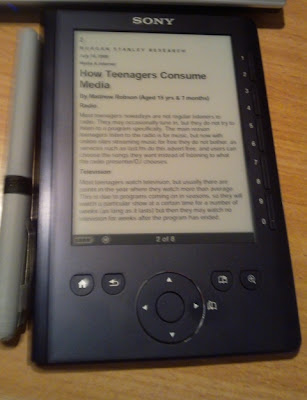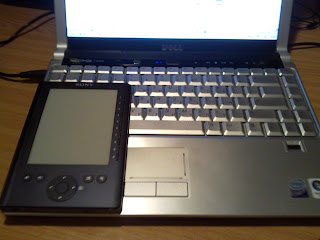We just got our new Sony Reader Pocket Edition, also known as PRS-300, and starting to realize its potential. First off – it’s a neat little gadget, and in Navy Blue it’s looking very cool! The screen is great, no reflection, and the E-Ink technology gives the pages a ‘book-like’ feeling. There’s some delay when the screen is flipping, but it’s definitely tolerable.
 My main concern was for PDFs and the way the Pocket will deal with the formatting of such files, especially when zooming. The Pocket has 3 zoom options: Small (S) – the default size when opening a PDF file, Medium (M) and Large (L). Small is not an option, unless you have super-sight or something – you see a full page, but there’s no way a human can read it. Medium is my preferred zoom, but I did notice an issue with charts and graphs – these force the page back to Small, and there’s no zooming. I uploaded my reader with Morgan Stanley’s report ‘How teenages consume media‘, by Matthew Robson. The 8-page PDF looks great on the screen, much like real paper, and there’s no trouble reading it, BUT, much like with graphs, the ‘Disclosure Section’ on page 5, refused to zoom in, despite several attempts. Will explore this issue more.
My main concern was for PDFs and the way the Pocket will deal with the formatting of such files, especially when zooming. The Pocket has 3 zoom options: Small (S) – the default size when opening a PDF file, Medium (M) and Large (L). Small is not an option, unless you have super-sight or something – you see a full page, but there’s no way a human can read it. Medium is my preferred zoom, but I did notice an issue with charts and graphs – these force the page back to Small, and there’s no zooming. I uploaded my reader with Morgan Stanley’s report ‘How teenages consume media‘, by Matthew Robson. The 8-page PDF looks great on the screen, much like real paper, and there’s no trouble reading it, BUT, much like with graphs, the ‘Disclosure Section’ on page 5, refused to zoom in, despite several attempts. Will explore this issue more.
The reader remembers the last state of every book you opened, and clicking ‘Continue Reading’ button will send you to the page you were in. There’s also the option to bookmark a page with a little ‘dogear’ on the upper right corner – nice. A search option would have made this device even better, much like adding a dictionary feature – the latter available in other models.
Working with the Pocket is very intuitive, and the PC/Mac compatible Sony eLibrary software auto-installs when plugging your reader via USB for the first time. Charging is also done via USB – there’s an AC socket, but no power adapter supplied in the package, only USB cable. Your reader appears as another disk drive, and you can drag-and-drop files to the Documents folder. However, if you want to organize your books/documents in Collections, you need to use Sony eLibrary software, where you can browse Sony’s collection (some free, most are not), as well as Google Books – over 1 million free public domain books. Too bad that Sony eBook Store doesn’t work outside the US/UK/NL/CA – Sony, it’s time to accept globalization, someone even wrote a book about it…
The Reader Pocket comes with 512MB, about 440MB are available for you. It might seem little, compared to current storage volumes, but each eBook usually weighs below 500Kb, which means you can take with you between 250-350 titles – and that’s a lot of books. PDFs will take more space than books (about 1MB), but nevertheless – there’s plenty of room, especially if this is your first eBook reader. The Pocket older brother, the Touch, has the same 512MB internal memory but boosts 2 card slots, for SD card and Memory Stick, of up to 16GB. That’s huge! In terms of eBooks…
Overall, the Sony Reader Pocket is a great entry level reader – small enough, great screen, supports multiple formats and can operate for up to 2 weeks on a single charge. The downsides are lack of international support at Sony eBook Store and the PDF issue I mentioned – hope both will be resolved soon.
I already started filling mine up with PDFs and free books from Google – for 199US$ it’s an excellent gift for the holidays.
[Picture: Sony Reader Pocket resting on my Dell XPS M1330 laptop]


![Reblog this post [with Zemanta]](http://img.zemanta.com/reblog_e.png?x-id=2ca8ea14-a2d2-4e08-8ebd-cd373bf9fe94)